February 2020 is when I finally took the plunge into the magical, obsessive, therapeutic world of sourdough. Just before our world shutdown with the pandemic, quarantine, etc... Needless to say, I'm very glad I started when I did. I had an active, bubbly starter and the requisite variety of flours on hand before the stores were panic-raided and flour and yeast were suddenly nowhere to be found. I'm also glad that many of you have started making your own starters as a result of the nationwide yeast shortage (silver lining?). The wild yeast and fermentation process without a doubt make a bread (or crust) that is more flavorful. And having an active starter on hand means you don't need to worry about running out of yeast. It also means you can make this delicious no yeast sourdough pizza crust!
Jump to:
Recipe Background and Details
Saturday night is pizza night in our house (it used to be Friday!). And we've been making a really good, pretty standard pizza crust for years. Click here for my Basic Pizza Crust. And then I started adding some of my sourdough discard and it evolved into this Sourdough Discard Pizza Crust that uses yeast along with unfed sourdough starter. Then that got me thinking... could I make it with just sourdough starter and eliminate the need for commercial yeast entirely?
Down the google rabbit hole I went. I was disappointed to find so many so-called sourdough pizza crusts that used just a small amount of starter. These recipes relied on store-bought yeast for most of the leavening. Then I stumbled on this recipe: Sourdough Pizza Dough from Saveur and my quest was over. I made a few small tweaks, and have landed on what I feel is the perfect no yeast sourdough pizza crust.
More sourdough recipes to try
If you are new to sourdough be sure to check out my Sourdough Starter Guide for Beginners! And don't miss my other popular sourdough recipes: sourdough discard sandwich loaf, sourdough discard cinnamon rolls, buttery sourdough discard banana bread, and overnight sourdough pancakes (sourdough discard or active starter).
How to make no yeast sourdough pizza crust
Autolyse
First you will mix your bubbly, active starter with room temperature water, then stir in the flour. You'll let this messy mixture sit at room temperature for an hour or even two if your kitchen is quite cool. This is called 'autolyse.' One of those scary words you read at the beginning of your sourdough journey and think, "what have I gotten myself into?" It's just a resting period that allows the flour to hydrate and the glutens to develop with basically no effort on your part.
Salt and Coil Folds
Next you will introduce the salt and with wet fingers you'll give it a bunch of really good folds and flips and turns to get the salt mixed in. Then after 30 minutes you'll come back to your dough, give it a few folds and ignore it again for 30 minutes. You'll repeat this for 3 hours. For a great visual guide on coil folds, check out Bella's guide that I've listed below.
Bulk ferment then choose your own adventure
After the final set of folds, you will leave the dough to bulk ferment at room temperature for a few hours. After this, you will either bake your pizzas or stash the dough in the fridge until the next evening (or even a few days later). This is a very laid back sourdough recipe mainly because I made it that way and because that's the way I cook and bake.
Interested in sourdough but don't know where to start?
In addition to my no yeast sourdough pizza crust instructions, here are a handful of sourdough starter guides. They cover all the stages of sourdough.
- Baker Bettie: Her Instagram video tutorials were the reason I decided to make my starter. Very thorough, explained in simple language, and just easy to follow along with. Find her video series here: Sourdough for Beginners Video Series
- Displaced Housewife: Rebecca, one of my blogger/Instagram BFF's just released a sourdough starter guide. It is no-fuss, no-stress with a good bit of her signature humor and candor mixed in. Find it here: How to Make a Sourdough Starter
- Ful.filled: Bella's incredibly comprehensive sourdough guide came out just when my starter was at the point where I was ready to bake. It is packed with info, super-helpful videos on all the steps, and great resources for tools and supplies. Find it here: Basic Sourdough Bread Guide
And what to do with your sourdough starter when you need a break
- Cooking with Cas: Clark AKA Cas is a friend I've semi-recently made on Instagram and he is so smart and so funny. He offers such a wealth of knowledge on many food topics including sourdough. You'll see all of these qualities reflected in his article: So you've started making sourdough...now what? This is such a unique and important article. He teaches us all how to dry and freeze our starters for long-term storage. It's hard to imagine, but at some point you might just need a break from baking sourdough and constantly maintaining your beloved starter. This article is for when that time comes. This would also be handy if you want to ship your starter.
Related Recipes
More fun sourdough and sourdough discard recipes:
- Sourdough Ginger Molasses Cookies
- Soft Sourdough Snickerdoodle Cookies
- Sourdough Pumpkin Bread (discard or active starter)
- Sourdough Discard Apple Bread
If you are using an active sourdough starter, then no, your sourdough pizza crust does not need yeast. There are many sourdough pizza crust recipes that use yeast to speed up the process and skip the long-fermentation, but my sourdough discard recipe is a true no-yeast sourdough pizza crust.
Always use unbleached flour for sourdough, but for this sourdough pizza crust you can use bread flour, all purpose flour, a mixture of the two, or you can even replace a portion of the flour for whole wheat, rye, etc.
If your crust is tough after baking, it is likely because you removed too many bubbles while shaping the dough. And/or the oven was not hot enough when the pizza dough went in. Use a light hand when pressing the dough out into a circle and try to preserve those beautiful bubbles as much as possible.
I hope you'll let me know if you try this no yeast sourdough pizza crust recipe! Leave a comment and rating below if you make it! And come hang out on Instagram @wild.thistle.kitchen! It's always a good time - especially on pizza night!
Happy cooking and baking! xo - Anita
Print
No Yeast Sourdough Pizza Crust
One of the simplest, no-nonsense pizza crusts that uses just sourdough starter - no commercial yeast. The soft, bubbly dough transforms into a soft, chewy, flavorful crust with just the perfect amount of sourdough flavor.
- Yield: 2 twelve inch round pizzas
Ingredients
- 100 grams active, bubbly sourdough starter
- 375 grams room temperature water (1 ⅔ cup)
- 500 grams all-purpose flour (3 ⅔ cup), plus more for dusting
- 10 grams kosher salt (1 Tbsp.)
Instructions
- In a large bowl, use a wooden spoon or dough whisk to combine water with sourdough starter. Add the flour and continue stirring until the flour is totally hydrated and no dry spots remain. Set aside at room temperature for 1 to 2 hours.
- After resting the dough, sprinkle the salt over the surface and incorporate by gently kneading a few times right in the bowl. I find keeping a small bowl of water nearby helps with this process. The dough will be quite soft and loose to start; don't worry about kneading it smooth at this stage, just fold and turn until you don't see or feel the salt crystals anymore. Cover the bowl loosely with a lid or damp kitchen towel and set aside.
- After 30 minutes, perform first set of coil folds. Use wet hands to loosen the dough from one side of the bowl. Lift one side of the dough, stretching it up and folding under itself two times. Repeat this with all 4 sides.
- Cover the bowl again and set aside. Continue resting the dough, performing coil folds every 30 minutes for a total resting time of 3 hours.
- After your final set of coil folds, cover bowl and allow to sit at room temperature for 3 hours. The dough should be gassy, glossy, and very smooth.
- At this stage, the dough can be refrigerated overnight or up to 72 hours before shaping and baking; or it can be frozen - see notes section at bottom of recipe for freezing instructions. Or if you are ready for pizza NOW it can be divided in half and gently pressed and stretched into 12 inch rounds for pizza. (Lightly flour the dough and your work surface - I recommend doing this on parchment to make transfer to the oven much easier- do not use a rolling pin. You want this dough to be bubbly.)
- Top with whatever you love, just don't go too heavy on the sauce or toppings and weigh down the beautiful dough.
- You will bake these pizzas in a pre-heated 500 degree oven on a pizza stone or baking steel preferably. I bake mine for 6-7 minutes. Just keep an eye on them as all ovens are quite different.
Notes
You can replace 50 grams of the AP flour with whole wheat if desired. I just prefer the taste of all AP for my pizza crusts.
Feel free to make 3 or 4 smaller pizzas rather than 2 large.
I have doubled this recipe with excellent results, just make sure you use a really big bowl.
If you want to freeze the dough, do so after dividing and shaping into balls: Lightly spray each dough ball with cooking spray or lightly wipe with olive oil (making sure all sides are lightly covered). Place each ball of dough into individual re-sealable freezer bags. Seal, squeezing out all the air from the bag. Place in the freezer until ready to use. The pizza dough may be stored in the freezer for up to 3 months. When ready to use, remove from the freezer and place in your refrigerator 12 hours or overnight. Before baking, remove the dough from the refrigerator and bring to room temperature, let sit on the counter for approximately 30 minutes. You are now ready to stretch out your dough and prepare your pizza.
Recipe inspired by and adapted from Saveur.com
- Category: sourdough
- Method: baking

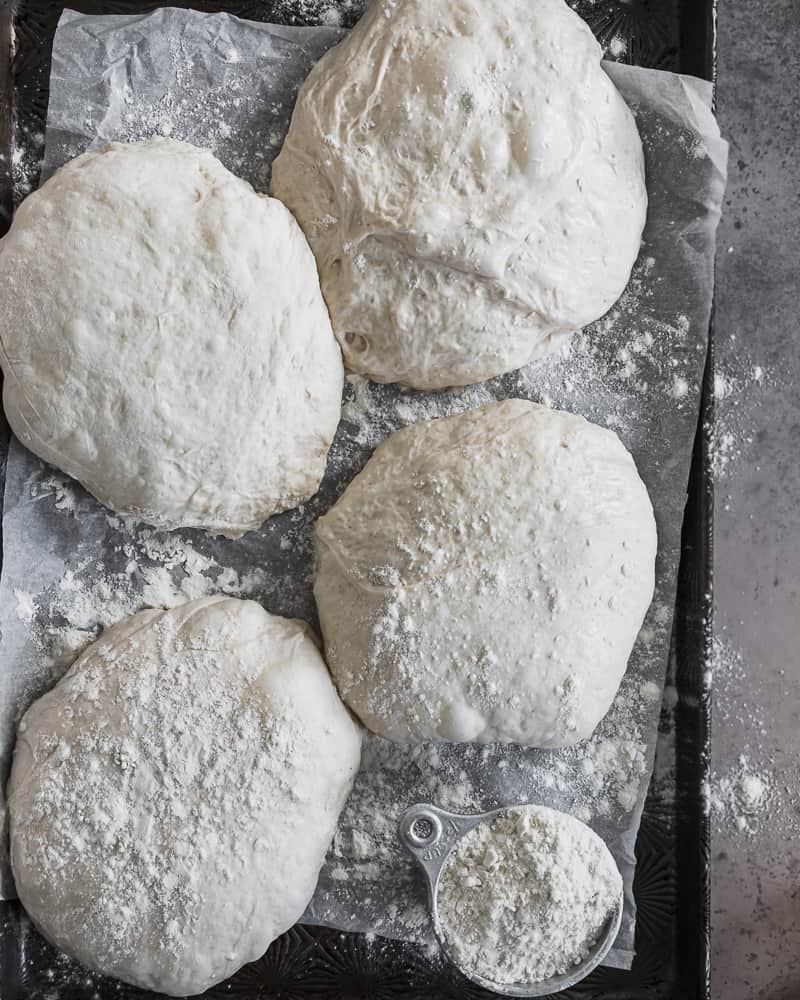

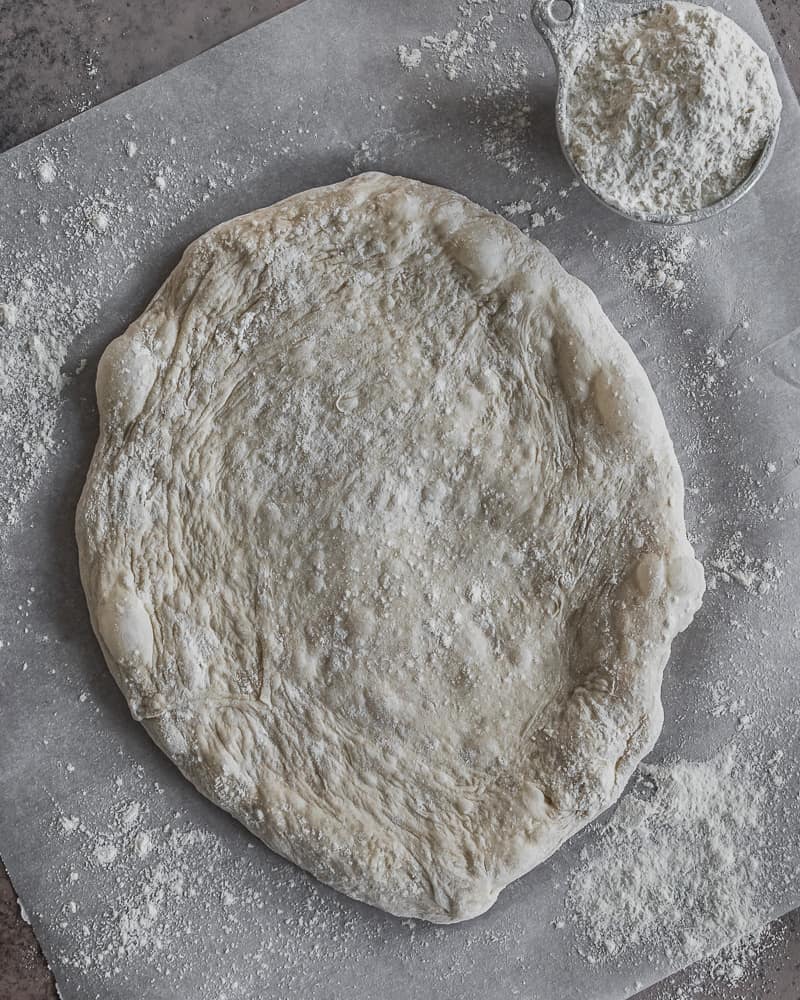



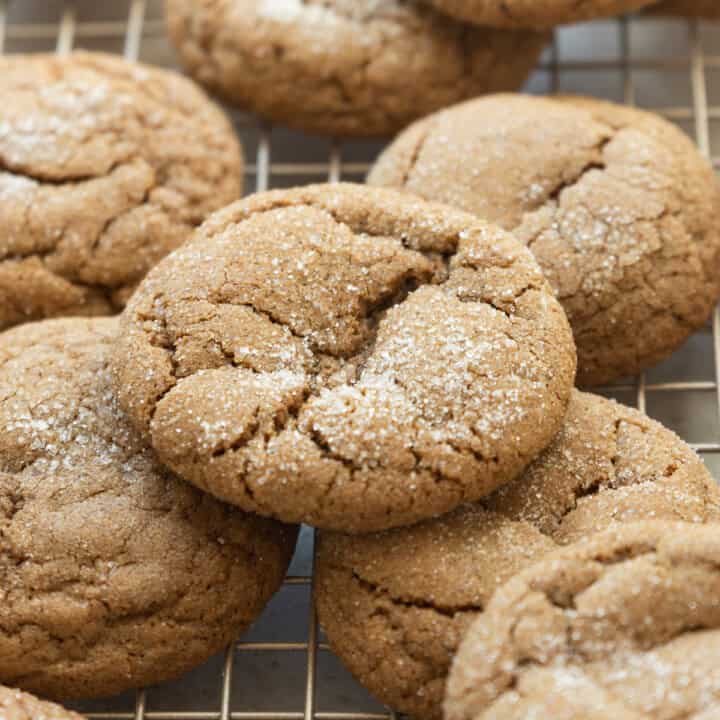
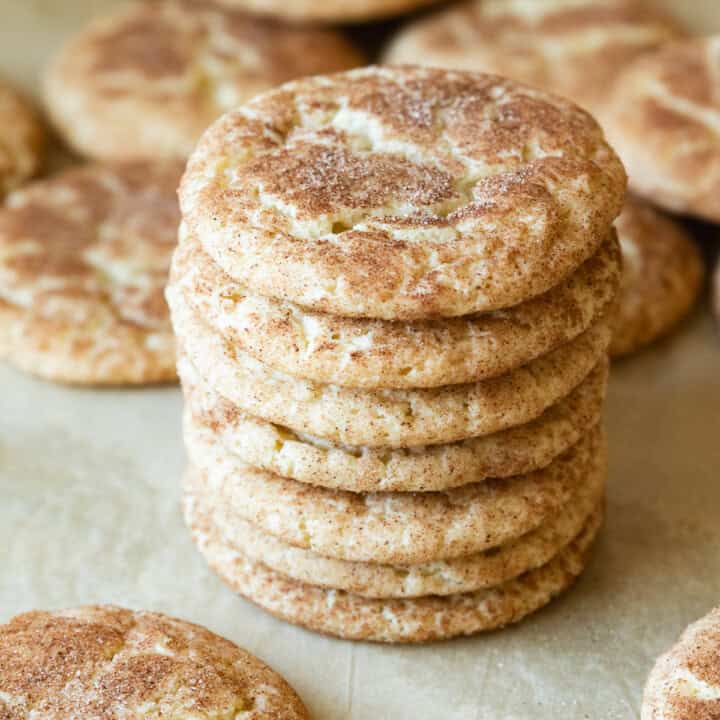
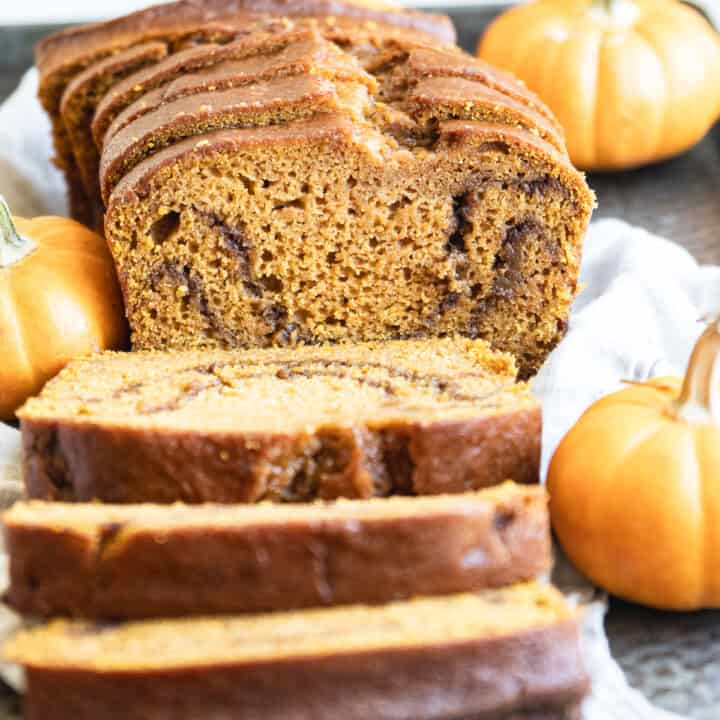
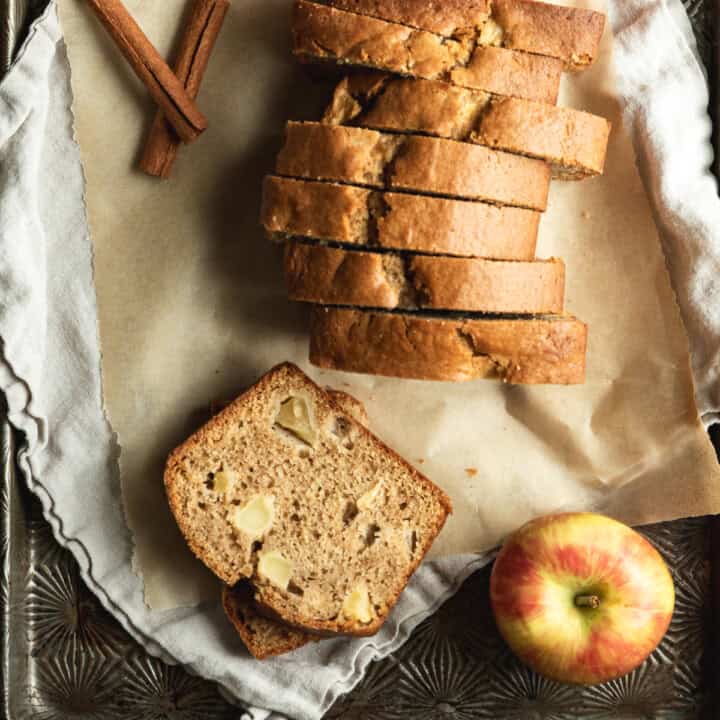
Trisha says
I doubled the recipe so I can make 4 large pizza doughs. My question is, can I section and shape after the first bulk ferment and leave them to ferment some more for a couple of days? I want to make one pizza right away and leave the rest to ferment for a bit longer
anita | wild thistle kitchen says
Hi Trisha! Yes, you can and I often do. Just like sourdough bread dough, this will last a few days in the fridge if covered well and you'll get some extra fermentation and tangy flavor. And as another bonus, I find it much easier to shape when it's cold. Let me know how you like it! Thanks for the question. - Anita
Hesperia Blackburn says
Hi! First time making this & I want to make sure I understand correctly the time. I thought I would be able to use this for tonight’s dinner but now I’m reading that it autolase 1-2 hrs, 3 hrs of folding in 30 min increments, then a finally 3 hr rise. Is that correct? From start to being able to use, 7-8 hrs
anita | wild thistle kitchen says
Hi! Yes, that is correct as this does not use any commercial yeast at all. I do also have a sourdough discard pizza crust recipe that uses a bit of yeast and is ready in about 2 hours. I do not have experience adding cornflour to my crust - so sorry! To make the crust thinner just press it out into a larger circle and be sure not to overload the toppings. Good luck and please let me know how it turns out for you!
Ruth says
I am looking for directions on how to use wild thistle for a sour dough starter. I think I have to remove the thorns near the flower and use the inner pulp. Do you have information on this?
anita | wild thistle kitchen says
Hi Ruth, no I do not have any information on that. It sounds very interesting though. Good luck in your search. - Anita
Jessica Norville says
Hi I am wanting to make this dough and use tonight. I see you made a comment after the freezer that if u want to do it now you can. Does this mean I can use it right away without doing any refrigeration? I’m sorry if this is a silly question
anita | wild thistle kitchen says
Hi! Not silly at all 🙂 Yes, you can use it right away and skip the optional refrigeration step. I hope you love it!
Hesperia Blackburn says
I love cornflour in my crust. Do you know how much or when I would add cornflour. I was thinking of substituting 100g of AP flour for cornflour.
Do you know how to make a thin crust? Thank you!
Elle says
Hi Anita,
I’m making this today (Wed) to bake for Saturday, do I need to let the dough come to room temperature before shaping and baking if it has rested in the fridge?
Thanks,
Elle.
anita | wild thistle kitchen says
Hi Elle! Yes, let the chilled dough come to room temp for 30 or so minutes before shaping and let it sit after shaping while you preheat the oven. I like this resting period because I feel like it results in a more bubbly crust after baking. Thanks for pointing out this detail - I will add it to the recipe card. Let me know how it turns out! - Anita
Sydney Dewees says
As silly as this is to comment after 4 years- it really is very delightful! My co workes all share a starter and try out recipes to let one another know how it turned out! This one was shared with me and oh my.. great! Very bubbly! I did try to bet mine a bit more wet than typical but that’s only due to my family love g crispy bubbly breads/ crust. We did two mini pizzas in cast iron pans in a convection oven setting- try that out if you can! Nice “bunt taste thanks to pre heating the pan and a drizzle of olive oil!
Brenda Archer says
This is the best sourdough pizza crust I have come across. It's the easiest to work with and is nice and airy! Thank you so much for sharing it.
Dawn says
I'm looking for a pizza dough recipe using my sourdough discard. Is there a way to adapt this recipe using the discard? Many thanks!
anita | wild thistle kitchen says
Hi Dawn - I think this would work well with a well-developed starter discard. I would not try it with a new/young starter. During the bulk ferment it will essentially be fed and will have a chance to get bubbly and active. I have not tried this myself but theoretically I think it would work well. Now I need to try it! Let me know if you do and how it goes.
Jason (Anita's husband) says
This is by far the best tasting pizza crust I have ever made! The taste reminds me of our son's favorite snack - Cheeze-Its!
Thank you so much for sharing your heart-felt story and amazing recipe with us. This recipe has become our weekly pizza Friday tradition.
Terry says
How important is the hydration level of the starter? I usually keep my starter at 100% hydration, but as you well know, this is a much wetter dough. Do I need a wetter starter as well?
anita | wild thistle kitchen says
Hi Terry - I'm sorry to say I'm not sure about that. I am not exact with my starter - I've gotten to a point where I just make sure it has a thick, pancake batter consistency when I feed it. As long as you start with a very established, active starter this recipe will work. If it seems excessively sticky and loose, I'd add a bit more flour. I hope that helps!
Robin says
Absolutely fabulous! I made one pizza and froze the other half of the dough for another time. The dough came together nicely and handled well- I didn’t find it too sticky at all for a high moisture dough. I used a regular baking sheet, 450 degree oven, 13 minutes.
Thank you for a true sourdough pizza crust recipe that doesn’t also need yeast.
anita | wild thistle kitchen says
Oh thank you, thank you! This makes my day! I am so happy you loved the recipe and that you didn't find it too sticky. And thanks for the comment and rating - it means SO much! xo - Anita
Lori says
Excellent flavor and our favorite pizza crust by far - we prebake for about 5 minutes before topping and baking - DELICIOUS!!
anita | wild thistle kitchen says
I'm so happy you love it! Pre-baking is such a great idea! I will have to try that next time. Thanks so much for the kind comment and review!! xo - Anita
Karlie says
Very tasty! A great crust! I also had a problem of it being too sticky but was able to work with it by flouring up my board and hands. I really wish I had a better way of spreading it out into. Standard circle! Too sticky to throw hahah! Very tasty and super easy! Thank you!
Anita Parris Soule | Cook on a Whim says
Hi Karlie! Thank you! I'm so glad you liked it and I really appreciate you taking the time to give your feedback!
Yes, the stickiness is just part of the fun (and sometimes frustration) of this type of highly hydrated sourdough dough. It makes it a bit harder to work with, but it really is necessary for the bubbles and texture of the final crust. Flour is your best friend, for sure. Haha. But, having written that, you can absolutely add more flour to the dough next time and still have very good results! Thanks again! - Anita
Rachel says
Hi Anita! Any idea why my dough is suuuper sticky? I live in a very hot and humid place so I'm assuming that my dough is fermenting faster than it otherwise might. But I don't think that it would have over-fermented after only two rounds of the 30 min/coil folds. Is it ok to just add more flour at this point even though it is past that initial resting phase? Thanks for any advice (even if it's after this first try ends!) 🙂
Anita Parris Soule | Cook on a Whim says
Hi Rachel! This is a very wet dough due to its high hydration level. It's kind of a pain to work with, but so worth it as the wetter dough results in a chewy, bubbly crust when baked! You can absolutely add a bit more flour next time in the beginning to adjust to your hot and humid environment! Using wet hands while making the coil folds and then using plenty of flour when cutting and shaping the final dough makes dealing with the stickiness much easier!
Rachel says
Update– I did add a bit of flour and cut the bulk ferment time in half to account for the climate I'm in. It was still wet, but after seeing your comment confirming that it's supposed to be that way, I went forward with it after letting it refrigerate overnight and the result was DELICIOUS! The air pockets and bubbles were just delightful and the dough was both soft but crisp enough on the bottom to carry the toppings well. I topped it with a thin layer of olive oil and pesto, chopped up tomatoes, spinach, parmesan, garlic powder, and a few twists of cracked pink salt. Yum! I will definitely be making this recipe again. Thanks a lot and be well! <3
Anita Parris Soule | Cook on a Whim says
Thank you so much Rachel! I have found as the weather gets warmer and more humid around here, I've been adding a bit more flour too. I'll have to add a note to the recipe! I am so very happy you enjoyed it! thank you for your feedback and for the rating!! xo - Anita
Meghan says
Am I able to freeze the dough after I split it in step 5?
Anita Parris Soule | Cook on a Whim says
Hi Meghan! Yes, I found this info online. I will update the post as well for those who want to freeze the dough.
"Once the pizza dough is prepared, divide and form into dough balls. Optional: Lightly spray each dough ball with cooking spray or lightly wipe with olive oil (making sure all sides are lightly covered). Place each ball of dough into individual re-sealable freezer bags. Seal, squeezing out all the air from the bag. Place in the freezer until ready to use. The pizza dough may be stored in the freezer for up to 3 months.
When ready to use, remove from the freezer and place in your refrigerator 12 hours or overnight. Before baking, remove the dough from the refrigerator and bring to room temperature, let sit on the counter for approximately 30 minutes. You are now ready to stretch out your dough and prepare your pizza."
Thanks so much for your question! - Anita
Rebecca | DisplacedHousewife says
Hi Ani!! Thank you so much for including me in here!!! Your pizza and starter look glorious!! I can’t wait to try this!!! Love to you!! xox